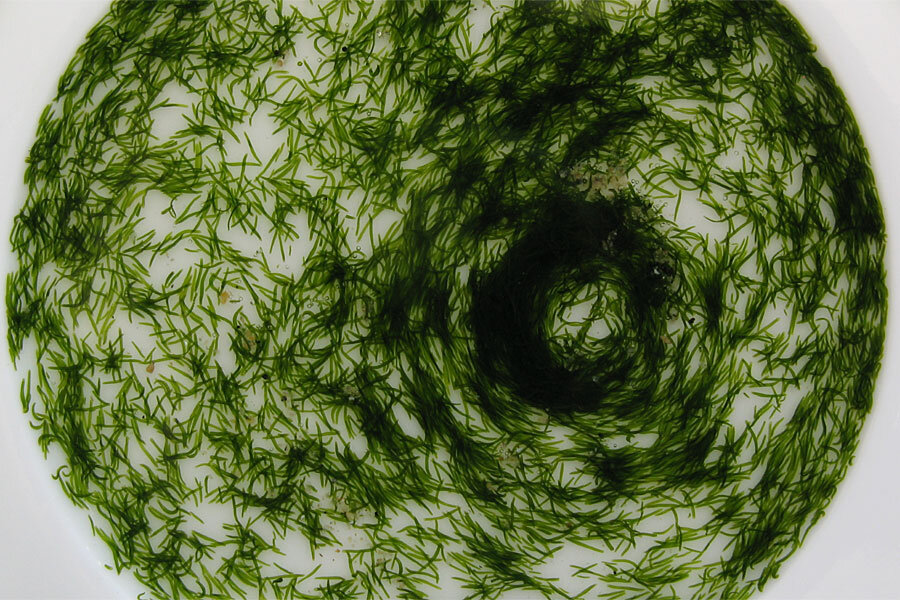These bizarre worms form social swirls while they sunbathe
Loading...
The tiny "mint-sauce worm" has long fascinated scientists because behaves like a plant: It "feeds" off the sun.
The green worm hosts a symbiotic species of algae. Those algae spoon-feed the animal all the sustenance it needs from the excess nutrients produced through photosynthesis.
But this strange little plant-animal does something else intriguing, too.
If you get enough of the tiny organisms together in shallow seawater, they start swimming around in a circle. Scientists studying the swirling mass suggest that this forms a sort of vortex, pulling more individual worms into the grouping. Such large-scale social behavior may be the key to the tiny animals' survival and odd eating habits, the researchers suggest in a paper published Tuesday in the journal Proceedings of the Royal Society B.
Picture "thousands of worms all sweeping around in a beautiful circular motion," study lead author Nigel Franks describes in an interview with The Christian Science Monitor.
Dr. Franks, who has primarily studied ant colonies, says that other organisms, like army ants, also display circular milling, as the swirl is called. But Franks was intrigued by these worms because, unlike other animals he has observed, they began milling without hesitation as soon as there reached a critical mass of worms.
The worms must feel a powerful social attraction, Franks surmised. "Circular milling normally occurs because the animals are attracted to one another," he explains. To test that theory, the researchers isolated the worms to see how they interact with each other on an individual basis.
The researchers built a computer simulation to test if the worms could interact in this same way at random. By programming the virtual worms to move around just as the real worms do, the scientists created something to compare to the live worms in a petri dish.
"What we found out was the real worms were bumping into each other much more frequently than you'd expect if they were oblivious to one another," Franks says, which confirmed the idea that the worms felt some sort of social attraction to each other.
And when the researchers programmed the virtual worms to be attracted to each other, the same sort of milling behavior emerged among a dense group of the computer-generated organisms.
So what purpose could circular milling serve for the little green worms?
In other animals, circular milling can be detrimental, says Franks. In army ants, for example, such a formation can prove deadly to the ants as they run in circles until exhaustion hits, but, mercifully for the ants, this behavior is rare. But, occurring more frequently, it seems to be beneficial for the plant-animal worms, Frank suggests, possibly because it increases the size of the aggregation.
As the worms spin, he explains, the growing vortex pulls in more and more worms, eventually forming a vast sheet. Perhaps there is safety in numbers or perhaps such massive biofilms could lend the tiny worms stability in the shallow waters, Franks says.
But there's an even more intriguing theory: Mashed together, they form a more efficient solar panel.
This group setting lets the symbiotic algae thrive, suggests Douglas Zook, a biologist at Boston University who was not part of the study, in an email to the Monitor. Their location inside the worm not only offers the algae protection and delicious waste nutrients, but the little plants are "in biofilm arrays that allow for them to do their thing: photosynthesize."
Another possible explanation could solve a dilemma presented by recent research. A study published last year showed individual worms gravitating toward light that could be too intense for the photosynthesizing algae.
But as these massive aggregations tend to form in harsh conditions, perhaps the company of others allows the sunbathing worms to take breaks from the too-intense light. Franks compares this explanation to large groups of Emperor Penguins in Antarctica, in which the penguins take turns shielding the others from cold winds. In the worm bunch, individuals could burrow down among their neighbors to find a bit of shade when the sunlight gets too strong.
Understanding the social behavior of these unique plant-animal worms could help researchers better understand other animals, too.
"The organism belongs to a class of worms which are considered among the most ancient animals, called acoels," Volker Hartenstein, a biologist at the University of California Los Angeles who was not part of the study, says in an e-mail to the Monitor. "For that reason alone, any new information about the behavior (which is controlled by the nervous system) is important for researchers who study the evolution of nervous systems and behaviors."
Symsagittifera roscoffensis is a tiny worm, stretching to a half inch at the longest. Thanks to their algal companions, the worms are a brilliant green and look a bit like seaweed when they're all smushed together.
The worm gets its common name, mint-sauce worm, from its resemblance to the edible herbal mash.
"If you took a jar of mint sauce onto a beach and spilt it, it would look exactly like the worms. It's a very apt description, but it doesn't do them justice," Franks says. "They're absolutely beautiful."






